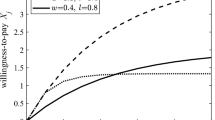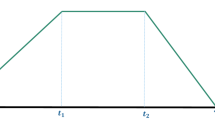Abstract
The Internet is changing the automotive industry as the traditional manufacturer and dealer structure faces increased threats from third party e-tailers. Dynamic pricing together with the Direct-to-Customer business model can be used by manufacturers to respond to these challenges. Indeed, by coordinating production and inventory decisions with dynamic pricing, the automotive industry can increase profits and improve supply chain performance. To illustrate these benefits, we discuss a strategy that incorporates pricing, production scheduling, and inventory control under production capacity limits in a multi-period horizon. We show that under concave revenue curves, a greedy algorithm provides the optimal solution, and we describe extensions to the model such as multiple products sharing production capacity. Using computational analysis, we quantify the profit potential and sales variability due to dynamic pricing, and we suggest that it is possible to achieve significant benefit with few price changes.
Similar content being viewed by others
Explore related subjects
Discover the latest articles, news and stories from top researchers in related subjects.References
Agrawal, V. and A. Kambil. (2000). “Dynamic Pricing Strategies in Electronic Commerce.” Working paper, Stern Business School, New York University.
Ahuja, R.K., T.L. Magnanti, and J.B. Orlin. (1993). Network Flows: Theory, Algorithms and Applications. New Jersey. Prentice Hall, Englewood Cliffs.
Baker, W., M. Marn, and C. Zawada. (2001). “Price Smarter on the Net.” Harvard Business Review 79(2), 122–126.
Biller, S., L.M.A. Chan, D. Simchi-Levi, and J.L. Swann. (2002). “Dynamic Pricing and the Direct-to-Customer Model in the Automotive Industry: Technical Results and Proofs.” Technical Report, Georgia Institute of Technology, available at http://www.isye.gatech.edu/jswann/publications.
Bjorner, A. and G.M. Ziegler. (1992). “Introduction to Greedoids.” In N. White (ed.), Encyclopedia of Mathematics and Its Applications: Matroid Applications. Cambridge University Press.
Chan, L.M.A., Z.J.M. Shen, D. Simchi-Levi, and J. Swann. (2004). “Coordination of Pricing and Inventory Decisions: A Survey and Classification.” In D. Simchi-Levi, S. D. Wu, and Z. J. M. Shen (eds.), Handbook of Quantitative Supply Chain Analysis: Modeling in the E-Business Era. Kluwer Academic Publishers, pp. 335–392.
Chan, L.M.A., D. Simchi-Levi, and J.L. Swann. (2002). “Applications of the Greedy Algorithm to Resource Allocation Problems and Three Types of Concavity.” Working Paper.
Eliashberg, J. and R. Steinberg. (1991). “Marketing-Production Joint Decision Making.” In J. Eliashberg and J.D. Lilien (eds.), Management Science in Marketing, Handbooks in Operations Research and Management Science, North Holland.
Elmaghraby, W. and P. Keskinocak. (2003). “Dynamic Pricing in the Presence of Inventory Considerations: Research Overview, Current Practices and Future Directions.” Management Science 49(10), 1287–1309.
Federgruen, A. and A. Heching. (1999), “Combined pricing and inventory control under uncertainty.” Operations Research 47(3), 454–475.
Gallego, G. and G. van Ryzin. (1994). “Optimal Dynamic Pricing of Inventories with Stochastic Demand over Finite Horizons.” Management Science 40(8), 999–1020.
Harris, F. and J. Finder. (1995). “A revenue management approach to demand management and order booking in assemble-to-order manufacturing.” Journal of Operations Management 13, 299–309.
Ibaraki, T. and N. Katoh. (1988). Resource Allocation Problems. Massachusetts: MIT Press, Cambridge.
Kay, E. 1998. “Flexed pricing.” Datamation, 44(2), 58–62.
Kearny, A.T. (1998). “The Future of Automotive Distribution.” FT Automotive 4.
Megiddo, N. (1974). “Optimal Flows in Networks with Multiple Sources and Sinks.” Mathematical Programming 7, 97–107.
J.D Power Automotive and Associates. (2000). “1999 New Autoshopper.com Study.” In The Power Report, January, Augora Hills, CA.
Sloan, A.P. 1963. My Years with General Motors, Currency and Doubleday, New York, NY.
Smith, M.D., J. Bailey, and E. Brynjolfsson. 1999. “Understanding Digital Markets.” In E. Brynjolfsson and B. Kahin (eds.), Understanding the Digital Economy. MIT Press (forthcoming) available at ecommerce.mit.edu/papers/ude.
Swann, J.L. (2001). “Dynamic Pricing Models to Improve Supply Chain Performance.” Doctoral Dissertation, Northwestern University, available at www.isye.gatech.edu/jswann.
Thowsen, G.T. (1975). “A Dynamic, Nonstationary Inventory Problem for a Price/Quantity Setting Firm.” Naval Research Logistics 22(3), 461–476.
Wall Street Journal (2001). “Lean Machine: How Dell Fine-Tunes Its PC Pricing.” June 8.
Washington Post. (2000). “On the Web, Price Tags Blur; What you Pay Could Depend on Who You Are.”
Whitin, T.M. (1955). “Inventory Control and Price Theory.” Management Science 2(1), 61–68.
Zabel, E. (1972). “Multi-Period Monopoly Under Uncertainty.” J. Economic Theory 5, 524–536.
Author information
Authors and Affiliations
Additional information
Research supported in part by ONR Contracts N00014-90-J-1649 and N00014-95-1-0232, NSF Contracts DDM-9322828, DMI-9732795 and DMI-0085683, a research grant from the Natural Sciences and Research Council of Canada (NSERC) a grant from General Motors, and a grant from the eBusiness Center at MIT.
Rights and permissions
About this article
Cite this article
Biller, S., Chan, L.M.A., Simchi-Levi, D. et al. Dynamic Pricing and the Direct-to-Customer Model in the Automotive Industry. Electron Commerce Res 5, 309–334 (2005). https://doi.org/10.1007/s10660-005-6161-4
Issue Date:
DOI: https://doi.org/10.1007/s10660-005-6161-4




